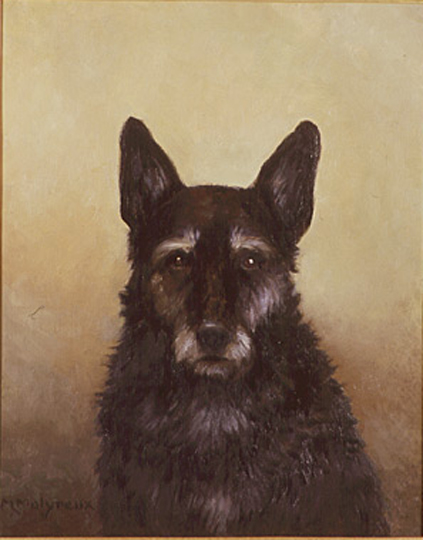
This is a legacy story from an earlier version of our website. It may contain some formatting issues and broken links.
There are five oil painting portraits of the family pet dogs at Preston Manor, pictures that are much-loved by people visiting the house. One day in 2017 a visitor exclaimed on seeing the portrait of Peter, ‘that’s our Alfie!’ and promised she’d send me a photograph to compare. These pictures are of Peter and his look-alike, Alfie. The similarity is uncanny.
The portrait of Peter was painted by Sussex artist, Maud Molyneux (1862-1947) who was the daughter of William Molyneux M.A., the Rector of the village of Twineham in West Sussex. Maud was born in Twineham Rectory. The 1911 census shows her living at 47 Portland Road, Hove aged 48 with her widowed mother and almost all her siblings, sisters Ethel and Beatrice an ‘authoress’ who wrote magazine articles and brother Ernest, a civil servant. There was another sister, the youngest, Mabel who was the only one of the four Molyneux sisters to marry and leave home. Maud, Ethel and Beatrice remained spinsters all their lives. Maud’s occupation in 1911 is given as ‘artist and teacher (drawing and painting) Visiting Mistress private schools’. She appears in the trade pages of the 1930 edition of Brighton & Hove’s Kelly’s Directory as an artist living at the same address. In 1911 brother Ernest is acting as head of the household looking after his mother and sisters aided by his regular civil service income. He was employed as a bankruptcy clerk for the Board of Trade.
Engaging Miss Molyneux to paint Peter’s portrait
Peter belonged to Charles Thomas-Stanford, second husband of Ellen Thomas-Stanford of Preston Manor. Ellen was described by her son John as ‘a terrible snob’. Therefore, it is possible that, in engaging Miss Molyneux, she was influenced by the fact her brother Ernest had a title, Sir Ernest Molyneux, 10th Baronet of Castle Dillion, County Armagh.
Ernest inherited his title though his Norman Molyneux ancestors. However, the title (created 1730) became extinct on his death. Ernest died at 6 Walsingham Road, an ordinary Victorian villa-style house near the seafront in Hove on Boxing Day 1940. By a quirk of chance, Walsingham Road was named after Barbara Walsingham, wife of Sir Anthony Shirley who’s family owned Preston Manor for four generations from 1569. Ernest pre-deceased his sister; Maud who was four years older. Maud died 3rd March 1947 aged 85 leaving £597 to her sister, Beatrice. This amount would be the equivalent of about £25,000 in today’s money. We don’t know the fee Maud Molyneux was paid for painting Peter’s portrait, but judging by the sum left in her will, she was making a reasonable living by her art.
Peter sits for his portrait
There is no known record of the portrait of Peter being painted though we can assume Miss Molyneux came to Preston Manor at least to make preparatory sketches. She would also have wanted to meet her subject and get to know a little of his personality, which she so perfectly captures.
If Peter was painted in the mid-1920s Maud was in her mid-60s and at the height of her artistic powers. I am guessing that she worked fast with oil paint on canvas first preparing a plain parchment-coloured background, then adding Peter in swift loose strokes of the brush in a head and shoulders face-forward pose. At first glance it seems Maud has captured Peter in a grumpy moment, but on closer inspection, especially if you look into his eyes with those little hard white dots of reflected light, you see a look of inquisitiveness aided by his ears turned forward as he stares intently at his portraitist and at us, his observers. Judging by the grey on Peter’s muzzle, cheeks and eyebrows he is not a young dog. Visitors to Preston Manor enjoy guessing Peter’s mood. Is he really grumpy or is he displaying elderly dog qualities of patience, obedience and preference for a life better spent dozing in a basket?
What do we know about Peter?
Peter’s dates are 1914-1928 meaning he was 14 years old when he died. We know this because his tombstone can be seen in the Pet Cemetery in the Preston Manor walled garden. The inscription is worn and unreadable in parts but the words, ‘Peter, a True Scot’ can be read along with his dates. Peter was one of the last (if not the last) family pet to be buried in the cemetery when Preston Manor was a private house.
The only source of information about Peter in his lifetime is Margery Roberts, the daughter of Preston Manor’s first curator. When Preston Manor became a museum in 1933 Margery and her parents Henry and Margaret Roberts moved into the west wing of the house because Henry’s job came with accommodation. Born in 1908 Margery was 25 years old and had known the last private owners Charles and Ellen Thomas-Stanford when they were alive. Margery therefore got to meet the family pets of the 1920s.
In 1935 Margery wrote an article, ‘The Companionship of Dogs’ for the Sussex Daily News recollecting her memories of the Manor dogs she knew so well. Here she mentions Peter and Ellen Thomas-Stanford’s Pekingese, Kylin.
‘Peter was a Scotch terrier and he bit everyone in a white apron. This is contrary to the ways of many dogs who look upon an apron-clad person as someone who will give them forbidden bits of food from time to time. However, so firm was Peter in this dislike that when Mrs Magniac (twin sister to Miss MacDonald) dressed up in a maid’s uniform he failed to recognise his mistress and bit even her.
Peter was a black Scotch terrier belonging to Sir Charles. When he came to Preston Manor (originally, he belonged to Mr Curwen of Withdean Hall) it was wondered how he would get on with Kylin, the favourite; but they soon became firm friends. Peter was devoted to Sir Charles and always followed behind him carrying his stick. So proud was he of being allowed to carry it, that even though he was a great fighter, he would never then indulge in a scrimmage of any kind. That would have meant dropping the stick and so failing in his ‘trust’.
Reading Peter’s dislike of persons wearing aprons makes me hope Maud Molyneux wasn’t wearing a traditional artist’s smock over her clothes when she visited Preston Manor.
Margery’s pen-portrait of Peter gives us more of his character. She describes Peter as ‘a great fighter’ given to biting persons wearing aprons. This begs the question, why was Peter given away by Mr Curwen? Was Peter so unmanageable the Curwen family wanted rid of him? If this was so, Charles Thomas-Stanford’s dog-handling skills are proven in that he tames the fighter into devotion and avoidance of scrimmages, at least while the dog is carrying his master’s stick.
Peter and Alfie
I have seen a very rare photograph of Peter in a private collection of photographs from 1924 belonging to the daughter of a former Preston Manor lady’s maid. He is seated viewed side-on to the camera with nine members of domestic staff including Butler, Maurice Elphick and Housekeeper, Mrs Storey whose long black dress he sits against. The photograph is also proof that Peter and Alfie look like identical twins.
If anyone else has a dog that matches one of the dog portraits at Preston Manor they are welcome to make themselves known to me.
Paula Wrightson, Venue Officer Preston Manor



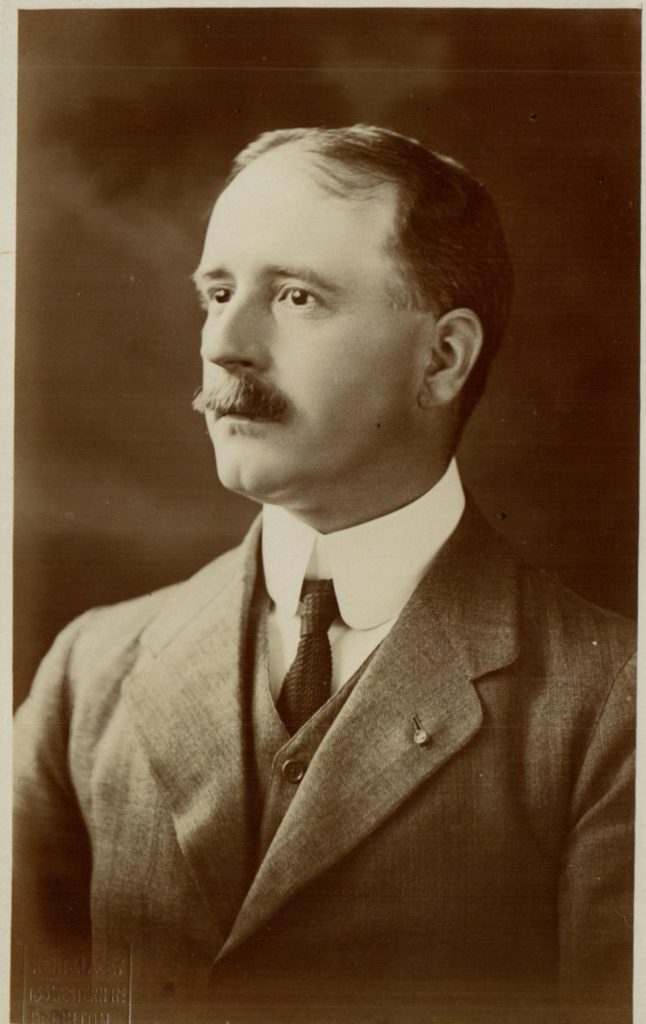



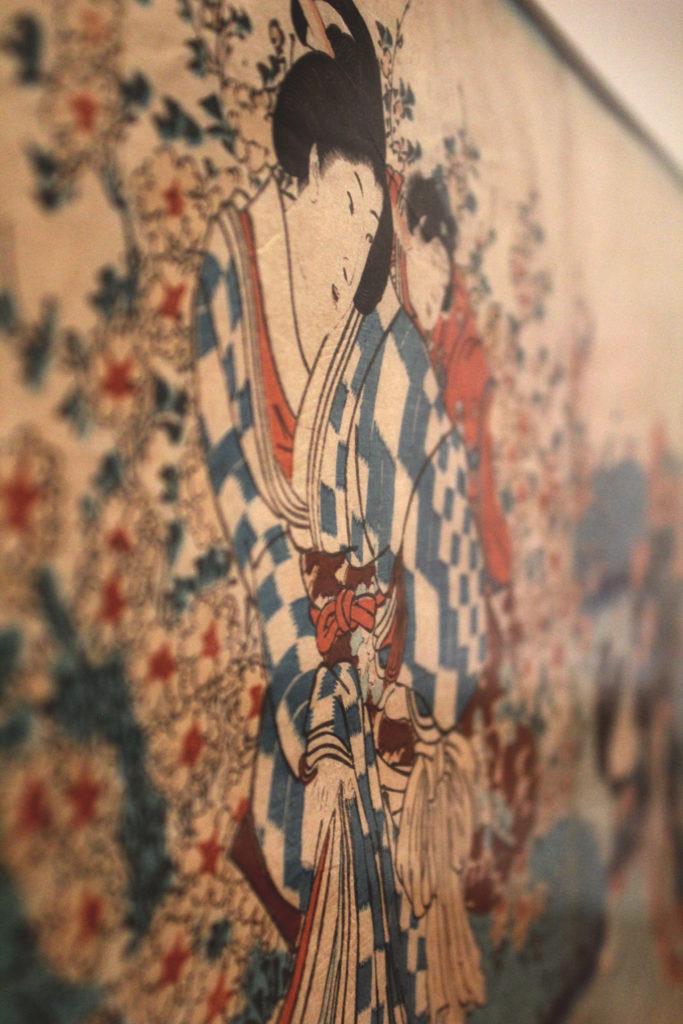









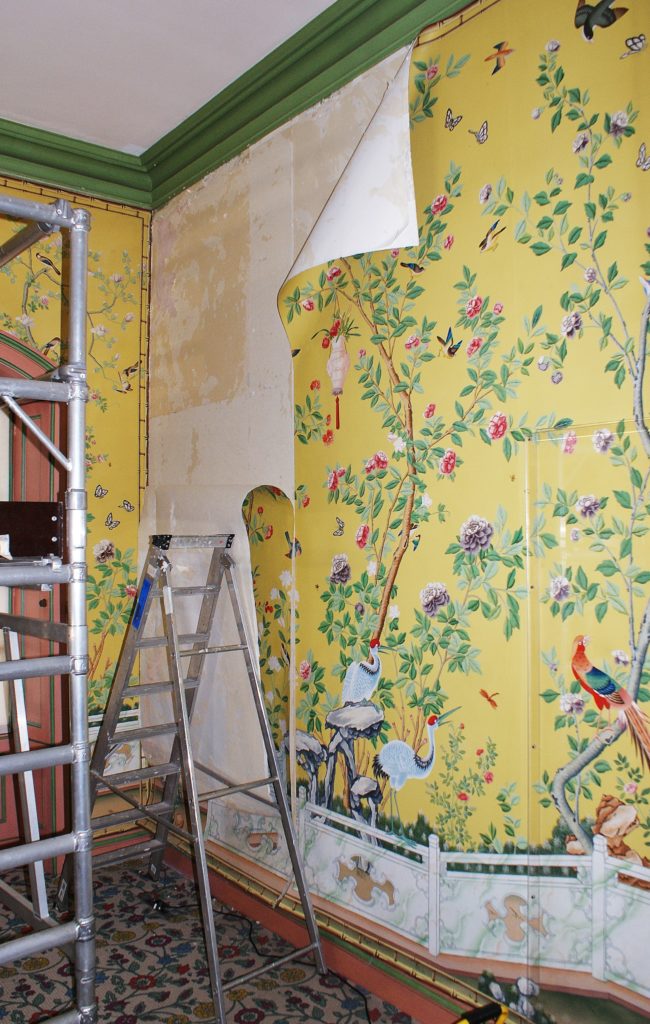









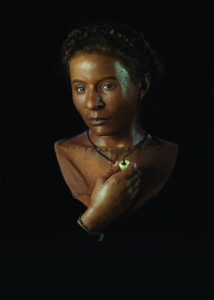

















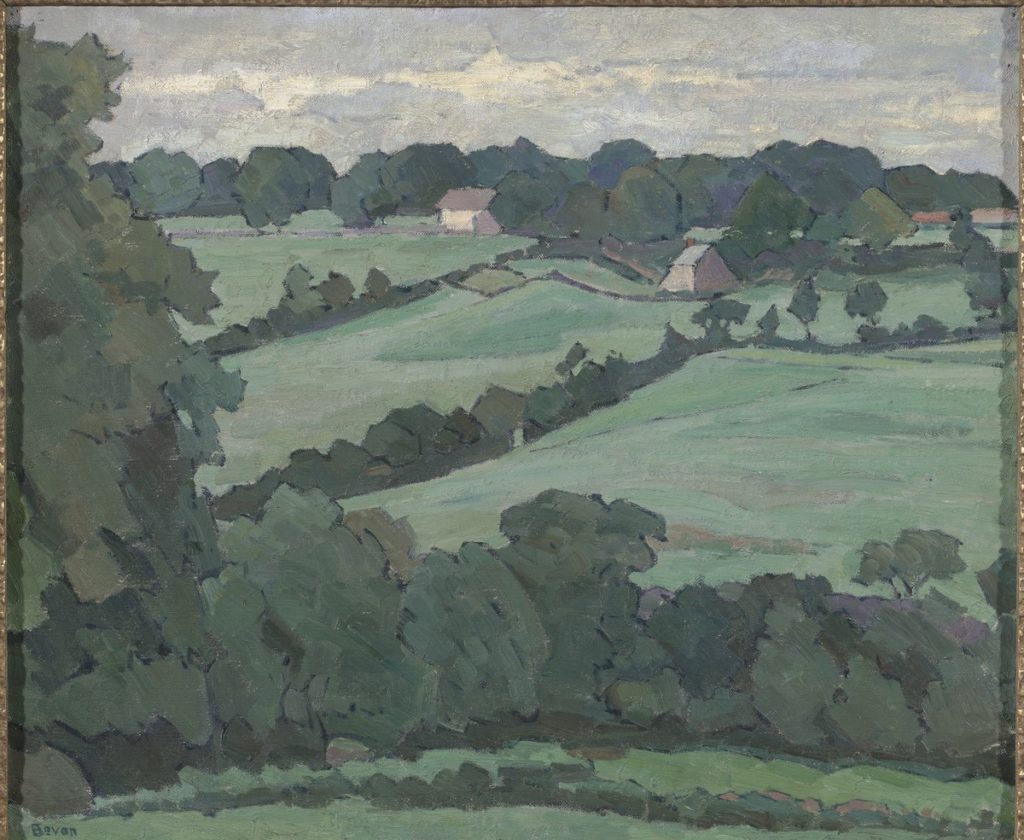




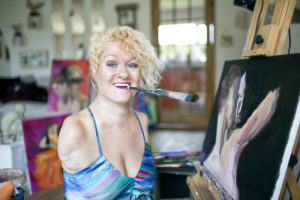

 Alison was transferred from the children’s home to an assessment centre to learn skills to enable her to live independently. She moved to London at age 19. A promising relationship, that resulted in marriage, turned abusive by her husband. She filed for divorce and moved forward with her art. At 25, Alison had gained an A Level in Art and it was suggested she study for a degree in Fine Art.
Alison was transferred from the children’s home to an assessment centre to learn skills to enable her to live independently. She moved to London at age 19. A promising relationship, that resulted in marriage, turned abusive by her husband. She filed for divorce and moved forward with her art. At 25, Alison had gained an A Level in Art and it was suggested she study for a degree in Fine Art. 